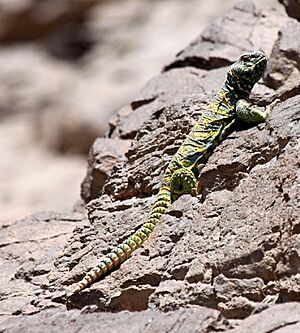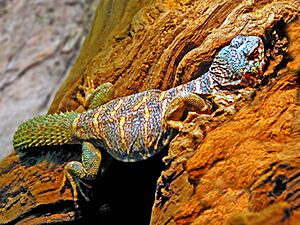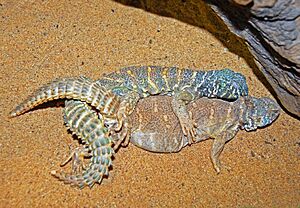Ornate mastigure facts for kids
Quick facts for kids Ornate mastigure |
|
|---|---|
 |
|
| Conservation status | |
| Scientific classification | |
| Genus: |
Uromastyx
|
| Species: |
ornata
|
| Synonyms | |
|
List
Uromastyx ornatus Rüppell, 1827
Uromastix ornatus A.M.C. Duméril & Bibron, 1837 Uromastyx ocellatus ornatus Arnold, 1986 Uromastyx ornata Wilms, 2001 |
|
The ornate mastigure (scientific name: Uromastyx ornata) is a type of lizard. It belongs to the family called Agamidae. These lizards are known for their bright colors.
Contents
What's in a Name?
The scientific name ornata means "ornate" or "decorated." This fits well with how colorful these lizards are. One of its subspecies, philbyi, was named after a British explorer, Harry St. John Bridger Philby.
Different Kinds of Ornate Mastigures
Scientists recognize two main kinds, or subspecies, of the ornate mastigure. They are slightly different but still belong to the same species.
- Uromastyx ornata ornata
- Uromastyx ornata philbyi
Where Do Ornate Mastigures Live?
These lizards are found only in the Middle East. They live in rocky areas across countries like Egypt, Israel, Saudi Arabia, and Yemen. They like places with lots of rocks where they can hide and find warmth.
What Do Ornate Mastigures Look Like?
An ornate mastigure can grow to be about 35 centimeters (14 inches) long. They are medium-sized lizards. These lizards are some of the most colorful in their group. Their bodies are often green, but they can also have yellow rings.
They have a long, spiky tail that is a bit flat. This tail has about 20 to 23 segments. You can also see small spines on the top of their thighs. There are a few larger scales near their ear openings.
Colors of Males and Females
Male and female ornate mastigures have different colors. This is called sexual dichromatism.
- Males are usually bright green, blue, or red. They have dark brown bands or round yellow spots. These spots often form rows across their backs.
- Females are not as brightly colored. Their backs are usually light brown. They have light yellow lines going across their bodies. Both males and females have whitish bellies.
How Ornate Mastigures Behave
Ornate mastigures are active during the day. They spend their days looking for food and basking in the sun. They usually live alone. Sometimes, you might find small groups with one male and a few females.
These lizards are good at digging. They dig burrows that can be up to 1 meter (about 3 feet) deep. These burrows provide a safe home and a cool place to escape the heat.
What Do They Eat?
Like most lizards in their group, ornate mastigures are mainly herbivores. This means they mostly eat plants. Sometimes, they might also eat insects.
Reproduction
During the breeding season, adult males become even more colorful. Their bright colors help them attract females.
Protecting Ornate Mastigures
The IUCN says that the ornate mastigure is a species of "Least Concern." This means they are not currently in danger of disappearing. However, in Israel, they are listed as "Endangered." This shows that their numbers might be dropping in some areas. Protecting their rocky habitats is important for their future.




